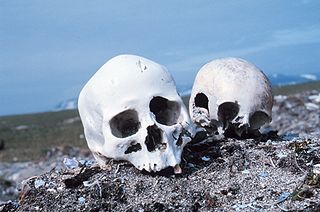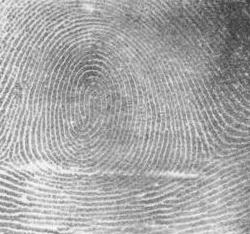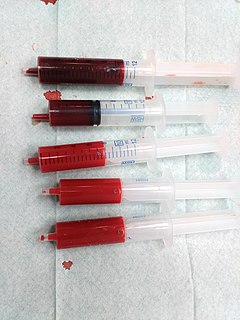
A crime scene is any location that may be associated with a committed crime. Crime scenes contain physical evidence that is pertinent to a criminal investigation. This evidence is collected by crime scene investigators (CSIs) and Law enforcement. The location of a crime scene can be the place where the crime took place, or can be any area that contains evidence from the crime itself. Scenes are not only limited to a location, but can be any person, place, or object associated with the criminal behaviors that occurred.

Trace evidence is created when objects make contact. The material is often transferred by heat or induced by contact friction.
Forensic identification is the application of forensic science, or "forensics", and technology to identify specific objects from the trace evidence they leave, often at a crime scene or the scene of an accident. Forensic means "for the courts".
The United Kingdom National DNA Database is a national DNA Database that was set up in 1995. In 2005 it had 3.1 million profiles, by 2015 it had 5.77 million and as of 2016 it has 5.86 million. The database, which was growing in 2007 by 30,000 samples each month, is populated by samples recovered from crime scenes and taken from police suspects although data for those not charged or not found guilty are deleted.
Since the early 1990s, American and International forensic science laboratories and practitioners have collaborated in Scientific Working Groups (SWGs) to improve discipline practices and build consensus standards. In 2014, the SWGs are being reorganized under the NIST Organization for Scientific Area Committees (OSAC).

Oil Red O (Solvent Red 27, Sudan Red 5B, C.I. 26125, C26H24N4O) is a lysochrome (fat-soluble dye) diazo dye used for staining of neutral triglycerides and lipids on frozen sections and some lipoproteins on paraffin sections. It has the appearance of a red powder with maximum absorption at 518 (359)nm.
Fingerprint powders are fine powders used in dusting for fingerprints by crime scene investigators and others in law enforcement. The process of dusting for fingerprints involves various methods intended to get the particles of the powder to adhere to residue left by friction ridge skin on the fingers, palms, or feet.
Crime reconstruction or crime scene reconstruction is the forensic science discipline in which one gains "explicit knowledge of the series of events that surround the commission of a crime using deductive and inductive reasoning, physical evidence, scientific methods, and their interrelationships". Gardner and Bevel explain that crime scene reconstruction "involves evaluating the context of a scene and the physical evidence found there in an effort to identify what occurred and in what order it occurred." Chisum and Turvey explain that "[h]olistic crime reconstruction is the development of actions and circumstances based on the system of evidence discovered and examined in relation to a particular crime. In this philosophy, all elements of evidence that come to light in a given case are treated as interdependent; the significance of each piece, each action, and each event falls and rises on the backs of the others."
The following outline is provided as an overview of and topical guide to forensic science:

Forensic footwear evidence can be used in legal proceedings to help prove that a shoe was at a crime scene. Footwear evidence is often the most abundant form of evidence at a crime scene and in some cases can prove to be as specific as a fingerprint. Initially investigators will look to identify the make and model of the shoe or trainer which made an impression. This can be done visually or by comparison with evidence in a database; both methods focus heavily on pattern recognition and brand or logo marks. Information about the footwear can be gained from the analysis of wear patterns which are dependent on angle of footfall and weight distribution. Detailed examination of footwear impressions can help to link a specific piece of footwear to a footwear imprint as each shoe will have unique characteristics.

Use of DNA in forensic entomology refers to the focus in forensics on one of the three aspects of forensic entomology. The three aspects are urban, stored product and medico-criminal entomologies. This article focuses on medico-criminal entomology and how DNA is analyzed with various blood-feeding insects.
Rape investigation is the procedure to gather facts about a suspected rape, including forensic identification of a perpetrator, type of rape and other details.
Touch DNA is a forensic method for analysing DNA left at the scene of a crime. It is called "touch DNA" because it only requires very small samples, for example from the skin cells left on an object after it has been touched or casually handled, or from footprints. Touch DNA analysis only requires seven or eight cells from the outermost layer of human skin. The technique has been criticized for high rates of false positives due to contamination—for example, fingerprint brushes used by crime scene investigators can transfer trace amounts of skin cells from one surface to another, leading to inaccurate results. Because of the risk of false positives, it is more often used by the defense to help exclude a suspect rather than the prosecution.
Forensic serology is the detection, identification, classification, and study of various bodily fluids such as blood, semen, saliva, urine, breast milk, vomit, fecal matter and perspiration, and their relationship to a crime scene. A forensic serologist may also be involved in DNA analysis and bloodstain pattern analysis. Serology testing begins with presumptive tests which gives the analyst an indication that a specific bodily fluid may be present, but cannot completely confirm its presence. Following the presumptive tests, are the confirmatory tests that confirms what the unknown substance actually is.

Glove prints, also sometimes described as gloveprints or glove marks, are latent, fingerprint-like impressions that are transferred to a surface or object by an individual who is wearing gloves.
Contamination is the introduction of something to a scene that was not previously there. This means trace materials are added to a crime scene after the crime is committed. This can happen before, during and after authorities take samples of the evidence from a scene. Many people can contaminate the evidence at a crime scene, including witnesses, suspects, victims, emergency response personnel, fire fighters, police officers and crime scene investigators. Juries expect to see forensic evidence before they make a decision in a case which relies on that evidence. Because of this, attorneys on both sides try to discredit forensic evidence that does not support their clients' interests. This requires crime scene investigators be especially careful to guard against contamination in the forensic samples taken from a crime scene. A miscarriage of justice can occur when these procedures are not carried out carefully and accurately.

Forensic firearm examination is the forensic process of examining the characteristics of firearms as well as any cartridges or bullets left behind at a crime scene. Specialists in this field are tasked with linking bullets and cartridges to weapons and weapons to individuals. Obliterated serial numbers can be raised and recorded in an attempt to find the registered owner of the weapon. Nitric Acid (HNO3) is the most common reagent used for this. Examiners can also look for fingerprints on the weapon and cartridges. Fingerprints are key pieces of evidence. If Crime Scene Investigators find prints at a scene, the will be dusted, photographed, collected, and analyzed both by hand as well as compared to databases for potential references.










